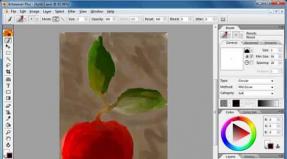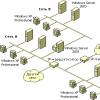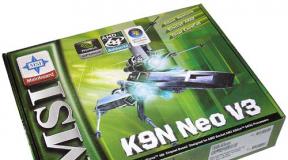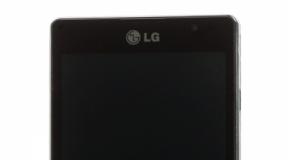Acoustic system amphiton 50ac 022. Soviet acoustics. Electrical circuit diagram
Manufacturer: PA "Karpaty", Ivano-Frankivsk. Passport 50 AS-022 .
Purpose and scope: for high-quality reproduction of music and speech programs in stationary living conditions. The recommended power of a high-quality household amplifier is 20 - 80 W. The preferred installation option is floor-mounted. 50 AS-022 and almost identical speakers, not counting the color of the woofer diffuser, in 50 AS-022 it is white.
Specifications
3-way floorstanding speaker with bass reflex
Frequency range: 25 (-15 dB) – 25000 Hz
Frequency response unevenness in the range 100 – 8000 Hz: 8 dB
Sensitivity: 86 dB (0.39 Pa/√W)
Resistance: 4 ohms
Minimum impedance: 3.2 ohms
Nameplate power: 80 W
Short-term power: 150 W
Weight: 24 kg
Dimensions (HxWxD): 675x360x300 mm
Design Features
The speaker body is made in the form of a rectangular non-demountable box made of chipboard, veneered with valuable wood veneer. Wall thickness and front panel housing 18 mm. The design of the case includes elements that increase its rigidity and reduce the amplitude of vibrations of the walls, in particular, a wooden spacer is provided connecting the front panel and the backwall and located between the low-frequency head and the bass reflex hole.
A set of heads similar to those used in speaker system(PO "Radio Engineering") - manufactured by PA "Karpaty", Ivano-Frankivsk. The heads differ only in that the baskets, made by precision casting from aluminum alloys, have the appropriate shape, allowing them to be used as decorative parts appearance AC. This made it possible to refuse to use any additional decorative overlays in the speaker design.The midrange and tweeter heads are installed on the front panel asymmetrically relative to the vertical axis of symmetry of the speakers. To prevent the influence of air vibrations in the speaker housing that occur during operation of the midrange head on the characteristics of the midrange head, the midrange head is isolated from the inside from the total volume with a special sealed plastic cap.
On the front panel of the speakers, in addition to the heads, there is a rectangular bass reflex hole with dimensions 238 x 22 mm (depth 235 mm); a decorative nameplate framing this hole and containing the name of the speaker and its main specifications. On the nameplate there is an LED for the head overload indicator.
On a small panel located above the HF head, there are two level controls for the mid and high frequencies; control limits for the sound pressure level of mid frequencies up to -6 dB, high frequencies ±3 dB. The geometric dimensions of the bass reflex ensure that it is tuned to a frequency of 30 Hz.
The internal volume of the speaker is 57 liters. To reduce the influence on the frequency response of sound pressure and sound quality, the acoustic resonances of the internal volume of the housing, the latter is filled with a sound absorber, which is mats of technical wool, covered with gauze, evenly spaced and fixed on the internal walls of the housing.
Electrical filters are mounted inside the housing on a single steel chassis, providing electrical separation of the speaker bands into low-, mid- and high-frequency. Each of them represents:
Filter circuit 50 AC-022 from the passport
low-frequency head filter - a first-order high-pass filter, provides a frequency response rolloff of 6 dB per octave;
filter of the mid-frequency head - a first-order bandpass filter, provides a decrease in the frequency response towards low and high frequencies of 6 dB per octave;
high-frequency head filter - filter low frequencies second order, provides a decrease in the frequency response towards the middle frequencies of 12 dB per octave.
The crossover frequencies between the LF and MF heads are 550 Hz, and between the MF and HF heads - 5000 Hz. The filter design uses resistors such as MLT-0.25, S5-35V, SP5-30, capacitors such as MBGO-2, K50-16, and inductors on plastic frames with air cores.
On the back wall of the speaker housing there are special clamps with spring-loaded contacts that allow you to connect the supply wires. The connection polarity is indicated on the AC terminals. There are four plastic feet installed on the base of the speaker.
Acoustic system "Amfiton 50AS-022"
Acoustic system "Amfiton 50AC-022/100AC-022" (1986)
Three-way speaker system Amphiton "50AS-022", she's the same Amphiton 100AS-022"", intended for playback sound programs from high-quality household amplification equipment.
Manufacturer of acoustic systems Amphiton "50AS-022" - Prykarpatsky Radio Plant (PO Karpaty), Ivano-Frankivsk (produced since 1986).
The acoustic systems Amfiton "50AS-022" and Amphiton "100AS-022" are completely identical and have the same power. Of the significant differences, we can only note the different color of the woofer diffusers. For the Amfiton "50AC-022" speaker it is white, and for the Amfiton "100AC-022" speaker it is black.
Heads:
With the help of passive separation filters, the entire frequency range of the Amphiton "50AS-022" speaker system is divided into 3 bands, each of which is reproduced by its own head.
The Amphiton "50AS-022" speaker system has three heads:
- low-frequency type 30GD-11 (75GDN-3),
- mid-frequency type 15GD-11 (20GDS-3),
- high-frequency type 6GDV-7.
Peculiarities:
A distinctive feature of this speaker is the use in the “50AC-022” version of a low-frequency speaker with a white diffuser, making it easily recognizable among models of similar speaker systems. In addition, standard dynamic heads were manufactured by the Carpathian Radio Plant specifically for these speaker systems. The difference between these heads and serial models is that their baskets are made of precision casting from aluminum alloys and have a special shape that allows them to be used as decorative parts for the appearance of speakers.
The body of the Amphiton "50AS-022" (35AS-218) acoustic system is made in the form of a bass reflex.
AS Amphiton "50AS-022" has two attenuators for changing the sound pressure level of medium and high frequencies. The controls are located on a small panel located above the HF head. The control limits are 6 dB for mid-frequency levels and 3 dB for high frequencies.
MAIN TECHNICAL CHARACTERISTICS:
Rated power, W................................................... ..... 50*.
Maximum power, W................................................... ... 80.
Reproducible frequency range, Hz.................... 25...25000.
Nominal sound pressure (100...4000 Hz), Pa............ 1.2.
Nominal electrical resistance, Ohm.................... 4.
Dimensions, mm................................................... .......... 675x360x300.
Weight, kg................................................... ................................... 24.
(*All official reference books for this speaker indicate a rated power value of 50 Watts. In fact, the rated power of this speaker is 25 Watts.)
Uneven frequency response at the bottom cutoff frequency the reproduced frequency range relative to the average sound pressure level is -15 dB.
The level of characteristic sensitivity is not less than 86 dB.
The unevenness of sound pressure in the frequency range 100..8000 Hz is ±4 dB.

Frame :
The case of the Amphiton "50AS-022" speaker is made in the form of a rectangular non-demountable box made of particle board covered with veneer imitating wood. The thickness of the case walls is 18 mm, the front panel is also made of a plate only 18 mm thick. The internal volume of the case is 57 liters. To reduce the influence of resonances, the internal volume of the speaker cabinet is filled with a sound absorber. To increase rigidity, the case design includes a wooden spacer connecting the front panel and the rear wall.
The bass reflex is set to a frequency of 30 Hz.
Separation filter:
Crossover frequencies: between the LF and MF heads - 550 Hz, between the MF and HF heads - 5000 Hz. The design of electrical filters uses resistors such as MLT-0.25, S5-35V, SP5-30, capacitors - MBGO-2, inductors - on plastic frames without cores.
- low-frequency head filter - first-order high-pass filter, provides a frequency response decline of 6 dB per octave;
- filter of the mid-frequency head - a first-order bandpass filter, provides a decrease in the frequency response towards low and high frequencies of 6 dB per octave;
- high-frequency head filter - second-order low-pass filter, provides a decrease in frequency response towards mid-frequencies of 12 dB per octave.

Speaker comparison:
The Amphiton "50AS-022" speaker, in comparison with the "S-90" speaker, has more compact dimensions and a slightly lighter weight, but a similar woofer head.
Amphiton "50AS-022" speakers actually have a lower rated power and occupy a junior position in relation to the "S-90" speakers.
In a blind test, the sound of the Amfiton "50AC-022" speaker can be distinguished from the sound of the older model - the Amfiton "35AC-018" speaker, as well as from the sound of the "S-90" speaker. A direct comparison of the Amphiton speakers “50AS-022” and “35AS-018” will show a slightly different sound character of these speakers.
Subjectively, the sound of the Amphiton "35AS-018" speaker is more powerful and assertive. And at the same time, it is much more detailed in the midrange, in the sound of guitars and vocals. For complex genres - rock, metal - they will be preferable.
For light instrumental genres, the Amphiton "50AC-022" speaker may be preferable. Its bass is softer, the mids have more mush but sound richer, and the highs are a little more sonorous. Also, the Amphiton "50AC-022" speakers cope well with electronic music (not chiselling, but music).
All of the above is absolutely subjective. The differences between the two speakers are minimal and during a blind test with a pause of 20-30 minutes, they are almost impossible to identify.
Although the Amphiton "50AS-022" speaker, in the author's opinion, is inferior in sound to the "S-90" speaker, it undoubtedly has a more original appearance and is significantly best quality assemblies. In addition, the targeted production of heads specifically for the Amphiton "50AS-022" speaker has led to the spread of the opinion that these heads have more high quality and a smaller spread of characteristics compared to their large-scale versions.
Also, these speakers are the only serial Soviet speakers with white diffusers. They definitely deserve a place on a collector's shelf.
Currently, Amphiton speakers "50AS-022" are sold at an inflated price compared to similar speaker models. This is in no way compensated by any advantages in their sound.
The bass and midrange heads of the "50AS-022" system, as well as similar heads in the Amphiton "35AS-018" speakers, were manufactured using foam rubber suspensions, the service life of which is 20±5 years. If pendants are exposed to direct sunlight for a long time, their service life is reduced to 7-10 years.
With a comparable or higher cost to the Amfiton "35AS-018" speaker and similar problems with the restoration of foam suspensions, purchasing the Amfiton "35AS-018" speaker seems more preferable. Of course, only if the speakers are planned to be used for listening.

Restoration of the Amphiton "50AS-022" speaker:
Currently, purchasing pendants is not difficult. Taking into account postage costs, a set for two woofers and two midrange speakers will cost 1000-1500 rubles, including postage costs. Repairs are quite painstaking and require extreme care and precision, which not everyone can do.
The method recommended for the Amphiton "35AS-018" speaker with complete replacement of the heads with similar heads with rubber suspensions (see the article about the Amphiton "35AS-018" speaker) is not acceptable in this case, because heads have different basket designs. In addition, non-serial heads are the main advantage of these speakers.
Therefore, if you want to use the Amphiton "50AS-022" speaker, the only option may be to purchase the Amphiton "50AS-022" speaker with "dead" suspensions and their subsequent replacement. I repeat, repairs are quite painstaking and require extreme care and accuracy, which not everyone can do.









I came across another version of the reincarnation of the famous set of speakers called Amphiton 50AC-022. The situation is standard, crumbling foam suspensions on the bass and midrange. We restore the low frequency, change the mid frequency to 30GDS, naturally with the filter recalculated. General photo for memory.

A closer photo of the mid-frequency driver; at the low frequencies, the cracks were initially weakly visible, but the sagging of the suspensions was critical (the coil was rubbing).

During the disassembly process, one problem emerged. The mid-frequency head looks like this.

I must admit, I thought that decorative covers were screwed on top of the standard heads. Well, I'm not good at imperial technology. Difficulties only stimulate the imagination. A heavy instrument in hand and instead of one speaker we have two halves. First.

Second. It should be noted that the goal is not to restore authentic acoustics, but to obtain a product with decent parameters. Therefore, a kilohertz scream under the knife without pity.

The third step is to mill the front panel for the new speaker and keep the appearance of the acoustics as close as possible to the original.

When removing the bass drivers, such an O-ring was discovered. It should be noted that among developers, opinions are divided into two. One opinion is that it is a good rubber ring for the speaker, and another is that the speaker is pressed to the front panel as tightly as possible without any seals. On the face is the second mounting option, adjusted for the cleanliness of the processing of the woofer speaker basket.


New hangers are in place.

Photo of the old filter.

We assembled the acoustics, measured the speakers, simulated the filter, built and tested a new one. Photo for memory.

The filter circuit will not be freely available. Final photo.

The reasons for replacing 20GDS-3 with 30GDS are described in more detail. They are similar in many ways for the entire line of acoustics with a similar set of speakers. In order to find a worthy replacement for the resulting acoustics, you will need to save up quite a significant amount. Within reasonable limits, of course.
Manufacturer: PA "Karpaty", Ivano-Frankivsk.
Purpose and scope: for high-quality reproduction of music and speech programs in stationary living conditions (performance category UHL 4.2 according to GOST 15150-69). The recommended power of a high-quality household amplifier is 20...80 W. The preferred installation option is floor-mounted
Specifications: DMPZ.843.020 TU.
As follows from the measurement results, the deviation of the frequency response measured in the horizontal plane is almost the same when measuring “to the right” and “to the left” from the axis in the frequency range up to 2 kHz (1...2 dB) and differs to a greater extent (6.. .8 dB) in the frequency range 2.5...6.3 kHz, i.e. in the band collaboration MF and HF heads. The deviation of the frequency response measured at angles in the vertical plane (“up”, “down”) up to 20 kHz does not exceed 2...4 dB, with the exception of the frequency of 4 kHz, where it is (when measuring down from the axis) 8... 10 dB, which indicates some asymmetry in the directional characteristics of the speakers in the vertical plane in the band, and the joint operation of the midrange and high frequency heads.

Shapes of frequency response of sound pressure:
It follows from the figure that the maximum value of the 2nd harmonic (about 1.5%) is in the range of 2...6.3 kHz; maximum values The 3rd harmonic (about 1.2%) is in the frequency ranges below 50, 150...500 and 800...2000 Hz. In addition, there is a narrow harmonic distortion peak in the 4 kHz region (up to 3%).
Specifications:
| Specifications | Meaning |
| Reproducible frequency range, Hz | 25...25 000 |
| Uneven frequency response of sound pressure, dB, at the lower limit frequency of the reproduced frequency range relative to the average sound pressure level | -15 |
| Uneven frequency response of sound pressure, dB, in the frequency range 100...8000 Hz relative to the average sound pressure level | ±4 |
| Level of characteristic sensitivity (characteristic sensitivity), dB | 86 (0,39) |
| The directivity characteristic of the speaker, dB, is determined by the deviation of the frequency response of sound pressure, measured at angles of 25±5° in the horizontal plane and 7° in the vertical plane from the frequency response measured along the acoustic axis of the speaker (0°): | |
| Nominal electrical resistance (nominal value of total electrical resistance), Ohm | 4 |
| Minimum value of total electrical resistance, Ohm | 3,2 |
| Maximum noise (nameplate) power, W | 80 |
| Maximum short-term power, W | 150 |
| Type of low-frequency acoustic design | bass reflex |
| Weight, kg | 24 |
| Dimensions, mm | 360x675x300 |

Shapes of the frequency response of sound pressure, measured in the horizontal plane at angles of 25° to the right and left, in the vertical plane at angles of 7° up and down
Design Features:
The speaker body is made in the form of a rectangular non-demountable box made of chipboard, veneered with valuable wood veneer. The thickness of the walls and front panel of the case is 18 mm. The design of the case includes elements that increase its rigidity and reduce the amplitude of vibrations of the walls, in particular, a wooden spacer is provided that connects the front panel to the rear wall and is located between the low-frequency head and the bass reflex hole.
A set of heads was used similar to that used in the acoustic system 35AS-012 (PO “Radiotekhnika”), manufactured by PA “Karpaty”, Ivano-Frankivsk. The heads differ only in that the diffuser holders, made by precision casting from aluminum alloys, have an appropriate shape that allows them to be used as decorative parts for the appearance of speakers. This made it possible to refuse to use any additional decorative overlays in the speaker design. The midrange and high-frequency heads are installed on the front panel asymmetrically relative to the vertical axis of symmetry of the speaker. To prevent air vibrations in the speaker housing that occur during operation of the bass head from affecting the characteristics of the midrange head, the midrange head is isolated from the inside with a special sealed plastic cap.
On the front panel of the speakers, in addition to the heads, there is a rectangular bass reflex hole with dimensions of 238x22 mm (depth 235 mm); a decorative nameplate framing this hole and containing the name of the speaker and its main technical characteristics. On the nameplate there is an LED for the head overload indicator.
A small panel located above the HF head contains two mid- and high-frequency level controls; control limits for the sound pressure level of mid frequencies up to -6 dB, high frequencies ±3 dB. The geometric dimensions of the bass reflex ensure that it is tuned to a frequency of 30 Hz.

Fundamental electrical diagram
The internal volume of the speaker is 57 dm3. To reduce the impact on the frequency response of sound pressure and the sound quality of speakers from the resonances of the internal volume of the housing, the latter is filled with a sound absorber, which is mats of technical wool, covered with gauze, evenly spaced and fixed to the internal walls of the housing.
Electrical filters are mounted inside the housing on a single steel chassis, providing electrical separation of the speaker bands into low-, mid- and high-frequency. Each of them represents:
- low-frequency head filter - a first-order high-pass filter, provides a frequency response rolloff of 6 dB per octave;
- filter of the mid-frequency head - a first-order bandpass filter, provides a decrease in the frequency response towards low and high frequencies of 6 dB per octave;
- high-frequency head filter - a second-order low-pass filter, provides a decrease in the frequency response towards mid-frequencies of 12 dB per octave.
The crossover frequencies between the low- and mid-frequency heads are 550 Hz, and between the mid- and high-frequency heads - 5 kHz. The filter design uses resistors such as MLT-0.25, S5-35V, SP5-30, capacitors such as MB GO-2, K50-16, and inductors on plastic frames with air cores.
On the back wall of the speaker housing there are special clamps with spring-loaded contacts that allow you to connect the supply wires. The connection polarity is indicated on the AC terminals. There are four plastic feet installed on the base of the speaker.
Design Features
The speaker body is made in the form of a rectangular non-demountable box made of chipboard, veneered with valuable wood veneer. The thickness of the walls and front panel of the case is 18 mm. The design of the housing includes elements that increase its rigidity and reduce the amplitude of vibrations of the walls, in particular, a wooden spacer is provided that connects the front panel and the rear wall and is located between the low-frequency head and the bass reflex hole.
A set of heads was used similar to that used in the acoustic system 35AS-012 (PO "Radiotekhnika") - 75GDN-3, 20GDS-3, 6GDV-7, manufactured by PA "Karpaty", Ivano-Frankivsk. The heads differ only in that the baskets, made by precision casting from aluminum alloys, have an appropriate shape that allows them to be used as decorative parts for the appearance of the speakers. This made it possible to refuse to use any additional decorative trims in the speaker design. The midrange and tweeter heads are installed on the front panel asymmetrically relative to the vertical axis of symmetry of the speakers. To prevent the influence of air vibrations in the speaker housing that occur during operation of the midrange head on the characteristics of the midrange head, the midrange head is isolated from the inside from the total volume with a special sealed plastic cap.
On the front panel of the speakers, in addition to the heads, there is a rectangular bass reflex hole with dimensions of 238x22 mm (depth 235 mm); a decorative nameplate framing this hole and containing the name of the speaker and its main technical characteristics. On the nameplate there is an LED for the head overload indicator.
A small panel located above the HF head contains two mid- and high-frequency level controls; control limits for the sound pressure level of mid frequencies up to -6 dB, high frequencies ±3 dB. The geometric dimensions of the bass reflex ensure that it is tuned to a frequency of 30 Hz.
The internal volume of the speaker is 57 liters. To reduce the influence on the frequency response of sound pressure and sound quality, the acoustic resonances of the internal volume of the housing, the latter is filled with a sound absorber, which is mats of technical wool, covered with gauze, evenly spaced and fixed on the internal walls of the housing.
Electrical filters are mounted inside the housing on a single steel chassis, providing electrical separation of the speaker bands into low-, mid- and high-frequency. Each of them represents:
low-frequency head filter - a first-order high-pass filter, provides a frequency response rolloff of 6 dB per octave;
filter of the mid-frequency head - a first-order bandpass filter, provides a decrease in the frequency response towards low and high frequencies of 6 dB per octave;
high-frequency head filter - a second-order low-pass filter, provides a decrease in the frequency response towards mid-frequencies of 12 dB per octave.
The crossover frequencies between the LF and MF heads are 550 Hz, and between the MF and HF heads - 5000 Hz. The filter design uses resistors such as MLT-0.25, S5-35V, SP5-30, capacitors such as MBGO-2, K50-16, and inductors on plastic frames with air cores.
On the back wall of the speaker housing there are special clamps with spring-loaded contacts that allow you to connect the supply wires. The connection polarity is indicated on the AC terminals. There are four plastic feet installed on the base of the speaker.



















